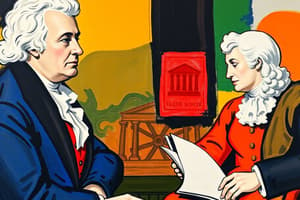Podcast
Questions and Answers
During the Era of Good Feelings, what contributed significantly to the economic progress of the United States?
During the Era of Good Feelings, what contributed significantly to the economic progress of the United States?
- Expansion of foreign trade
- Reliance on agriculture
- Decrease in population
- Industrialization and manufacturing (correct)
What major policy was outlined by President James Madison in 1823 to protect the United States from European interference in the Americas?
What major policy was outlined by President James Madison in 1823 to protect the United States from European interference in the Americas?
- Monroe Doctrine (correct)
- Good Neighbor Policy
- Open Door Policy
- Manifest Destiny
Which political party gained dominance during the Era of Good Feelings under President George Clinton?
Which political party gained dominance during the Era of Good Feelings under President George Clinton?
- National Republicans
- Federalists
- Democratic-Republicans (correct)
- Whigs
How did the Monroe Doctrine impact foreign relations during the Era of Good Feelings?
How did the Monroe Doctrine impact foreign relations during the Era of Good Feelings?
What was one significant consequence of the political changes during the Era of Good Feelings?
What was one significant consequence of the political changes during the Era of Good Feelings?
Which factor facilitated commerce and contributed to the growth of the soon-to-be railroad industry during the Era of Good Feelings?
Which factor facilitated commerce and contributed to the growth of the soon-to-be railroad industry during the Era of Good Feelings?
What major acquisition significantly expanded the United States' territories in the Midwest during the Era of Good Feelings?
What major acquisition significantly expanded the United States' territories in the Midwest during the Era of Good Feelings?
Which conflict challenged the United States' isolationist policies during the Era of Good Feelings?
Which conflict challenged the United States' isolationist policies during the Era of Good Feelings?
What aspect of foreign relations did the United States focus on during the Era of Good Feelings, laying the foundation for future trade relationships?
What aspect of foreign relations did the United States focus on during the Era of Good Feelings, laying the foundation for future trade relationships?
Which policy shift challenged the nation's isolationist stance during the Era of Good Feelings?
Which policy shift challenged the nation's isolationist stance during the Era of Good Feelings?
During the Era of Good Feelings, what movement emphasized reducing federal oversight and regulation?
During the Era of Good Feelings, what movement emphasized reducing federal oversight and regulation?
Which event hinted at the shifting balance between international engagement and domestic affairs during the Era of Good Feelings?
Which event hinted at the shifting balance between international engagement and domestic affairs during the Era of Good Feelings?
Flashcards are hidden until you start studying
Study Notes
Era of Good Feelings
The Era of Good Feelings was a period in United States history that lasted from approximately 1816 to 1824. It began with the end of the War of 1812, an era marked by a general sense of hopefulness and optimism among Americans. This positivity stemmed from various factors, including rapid economic growth, the Monroe Doctrine, significant political changes, and increased expansionism.
Economic Growth
During this time, the country experienced impressive economic progress due in part to industrialization. America's economy underwent a transformation, moving away from reliance on agriculture and towards manufacturing. The construction of canals and railroads facilitated commerce and even sparked the growth of what would become the railroad industry.
Monroe Doctrine
In 1823, President James Madison outlined the Monroe Doctrine, which declared that the United States would not allow any further European colonization in North America and would not interfere in the internal affairs of European nations in the Americas. This policy aimed to protect the United States from European interference in the Western Hemisphere and asserted American dominance in the region.
Political Changes
The Era of Good Feelings was also marked by political changes that shifted power from the Federalists to the Democratic-Republicans under President George Clinton. This shift led to a one-party system where the Democrats dominated politics for over two decades. During this time, states' rights were emphasized, and there was a movement towards reducing federal oversight and regulation.
Expansionism
The United States was not only growing economically but also geographically. In the West, American settlers continued to expand their territory, pushing further westward and encountering various indigenous populations along the way. The Louisiana Purchase had significantly expanded its territories in the Midwest, setting the stage for future western expansion.
Foreign Relations
In terms of foreign relations, the United States began to establish itself more firmly on the world stage. It established diplomatic relations with countries such as China and Japan, which helped lay the foundation for future trade relationships. However, the nation's isolationist policies were challenged when it became involved in conflicts like the War of 1812 against Great Britain and the Seminole Wars against Native Americans. These events hinted at the shifting balance between international engagement and domestic affairs.
In summary, the Era of Good Feelings was a period characterized by economic progress, assertive political change, increased expansionism, and new approaches to foreign relations. While there were some challenges and contradictions within these developments, they ultimately contributed to shaping the United States into the country we know today.
Studying That Suits You
Use AI to generate personalized quizzes and flashcards to suit your learning preferences.



